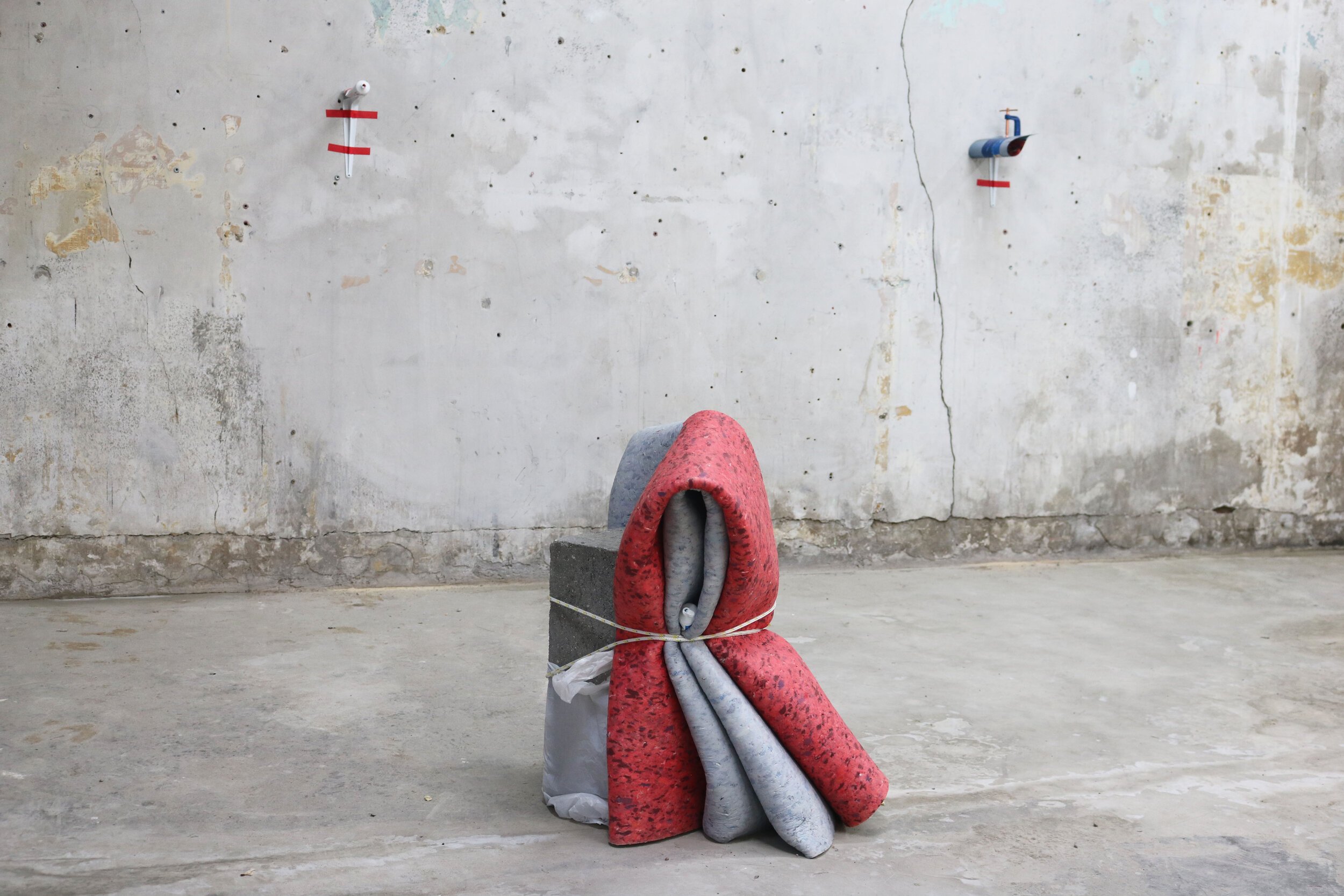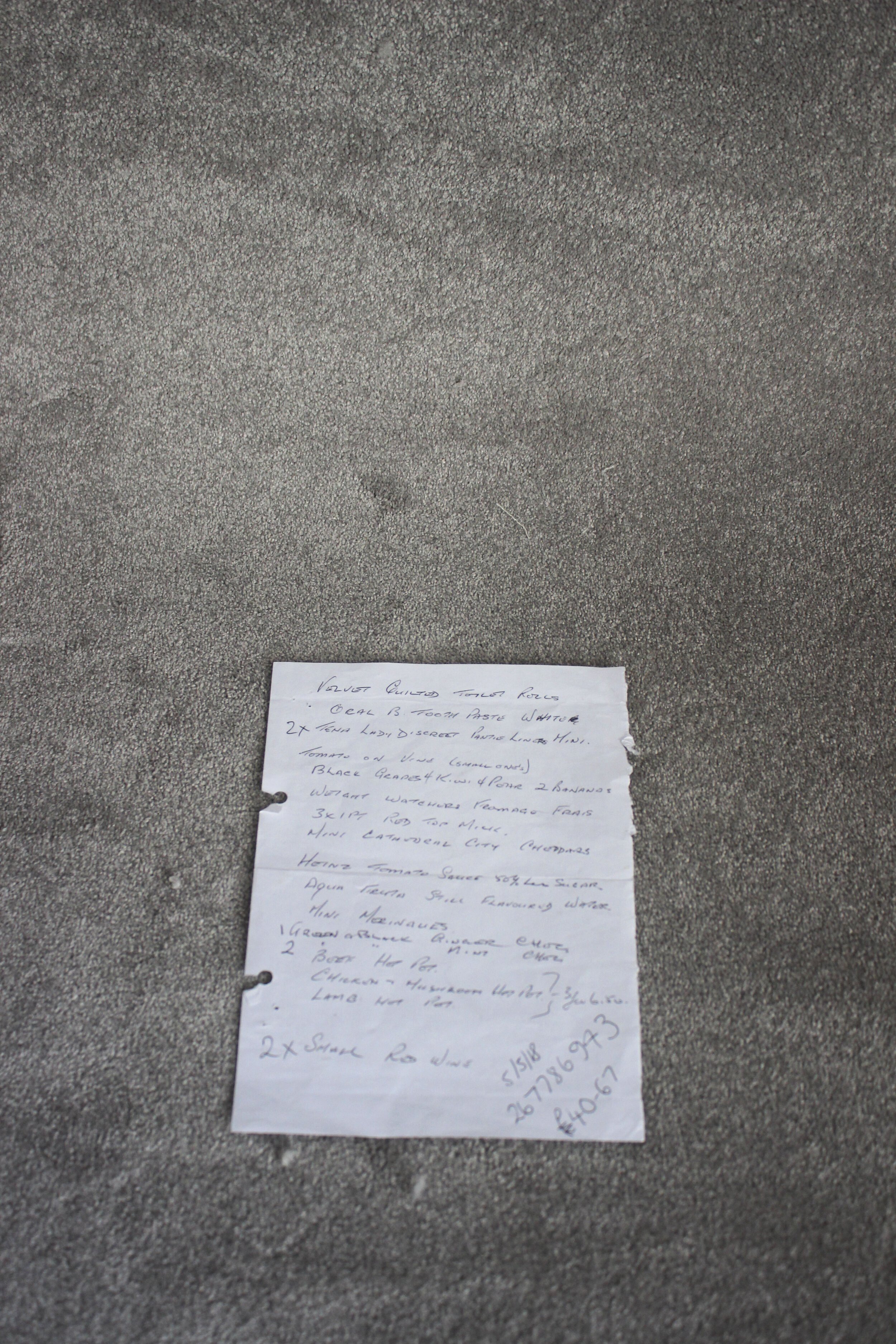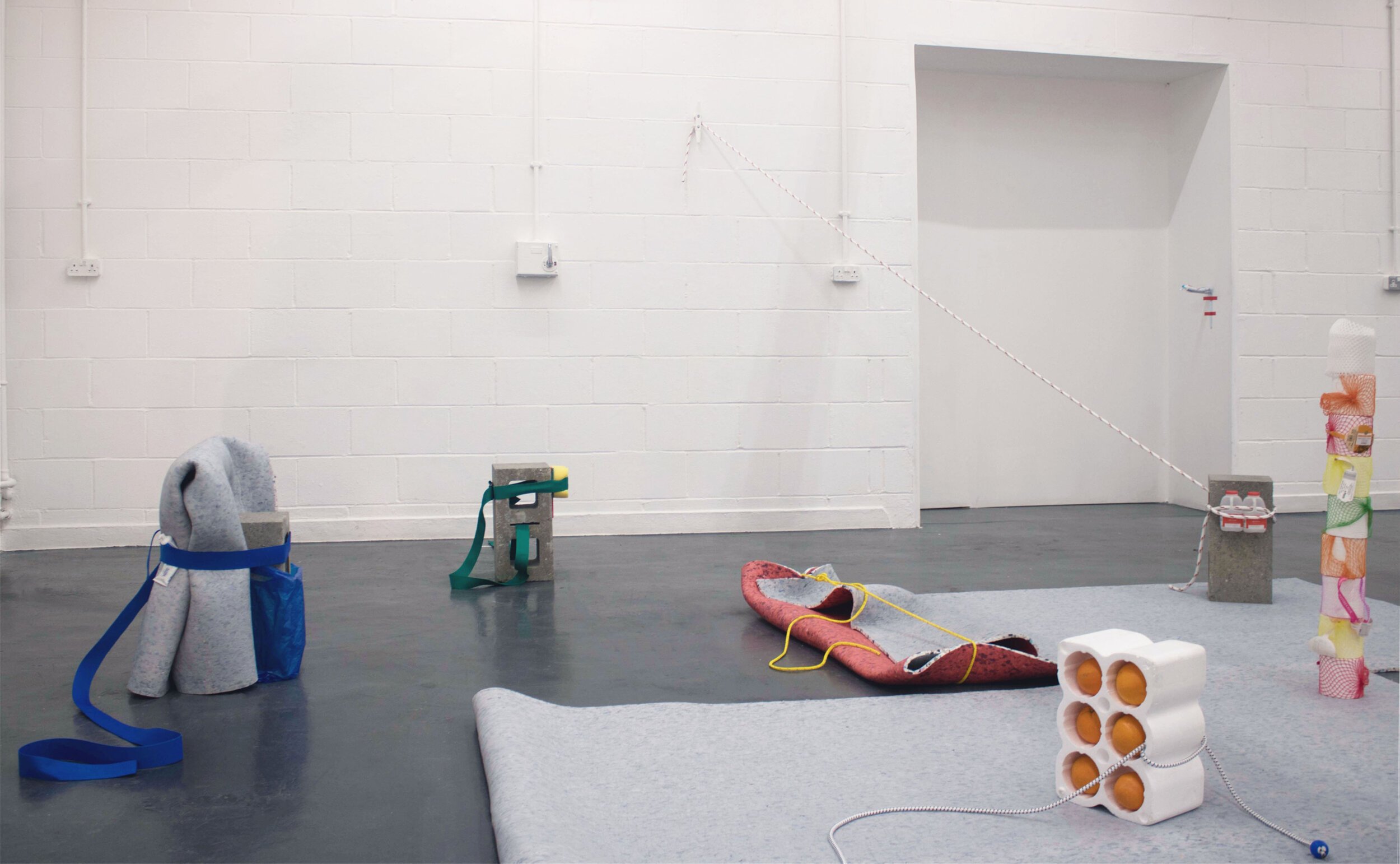Martha Scott
By Caitlin Dawkes
Raid.R Reporter Caitlin Dawkes in digital conversation with WCA (Wimbledon College of Arts) BA Sculpture graduate, Martha Scott.
Scott works with the forgotten, overlooked objects of the everyday. Fastening domestic and industrial materials together to create a unique experimental juxtaposition that interrogates the relationships between objects. We discuss how a mystery shopping list pathed the way to Scott’s current practice and why toothpaste makes a reoccurring appearance in her sculptural installations.
Keep an eye out for Scott’s work in the current and upcoming issues of A Home for Works, a self-publication project run by artists, Martha Scott and Tanith Price.
Installation View, Copeland Gallery, 2020, Dimensions Variable, Image Courtesy of Martha Scott
Often, multiple works are positioned together – so within each sculpture there are these relationships between the objects, and within the larger space there are these relationships and connections between the individual works, as well as the objects held within these.
I want people to notice these everyday objects that we overlook. I think a way of doing this is juxtaposing objects we don’t associate together – such as domestic and industrial ones. Removing them from their assumed context makes us see them in a different way. This familiarity and slight absurdity can feel almost tender and humorous. There’s something about this abundance, this mass of things we’re surrounded by, that I’m interested in. I’m not necessarily criticising this, because there’s a lot of beauty in it and it brings us a lot of pleasure. But, equally, it can be very problematic. I suppose bringing these objects, forcing them together, is a way for me to negotiate this.
CD: What was the particular moment that sparked the idea of using everyday objects as materials to make sculpture? Can you talk me through this moment?
MS: I guess this was something I was falling towards for a while during my degree – I was flirting with it for a couple of years. It took me some time to realise partly what I was trying to say about these objects would be better said by them themselves.
But, the real pivotal point was the summer before my third year, when I found a shopping list in a book from a charity shop. I could talk forever about this list and I wrote my dissertation on it (!). Long story short, it was written on the back of a letter addressed to someone called Pamela, and I deduced it was her shopping list. I kept it for a while not sure what to do with it, just knowing it intrigued me because of the precise nature of the descriptions of the items and the intimacy of this personal, but normally mundane, list and task, that had belonged to someone else. After a couple of months, seeing as I didn’t know where to start, I went out and did the whole shop. I brought it back to the studio and began playing with these objects, as I normally would have with my “made” artworks. Just assembling, arranging, photographing. I still use some of the items from Pamela’s list in my ongoing work. I’m not sure how much longer it would have taken for me to work out that’s what I wanted to be doing, if I hadn’t found the list.
Pamela’s List & Pamela’s Shopping Bag, 2019, Image Courtesy of Martha Scott
CD: I am curious to know at what point in the work's generation do the everyday objects turn into art objects? Do you think it is from the moment you choose an object? Can you talk me through the process of choosing an object to become part of your sculptures?
MS: Choosing my objects happens in a lot of ways, I think. Like how I mentioned Pamela’s list above, objects can arise quite organically like that. And sometimes it’ll be something I’ve stared at my whole life and I’ll just realise that I find it interesting. I think the familiarity is key, but I guess it’s about separating slightly from that, to see it as its form, it’s material properties and colours. A big part of my work is about noticing these mundane things, so I suppose I find objects just by noticing that they’re there, whether it’s on the street or in a house.
Other times, I’ll just walk around Travis Perkins or Wilko, because not everything reveals itself to you. I can’t pretend I’m not drawn to certain things aesthetically, certain colours cropping up and elements of text, the contrast between hard and soft textures. I’ve got better at taking photos of these things if I’m out, as something to reference back to when I’m making these decisions.
I would say they turn from object (when selected), to material (when I’m making with them) to then object (art object) once refined and within a space. When I’m arranging and playing with them, I slightly lose sight of them as objects as it becomes more about their materiality.
A Ship Can Carry A Boat (part 1), 2020, Metal bracket, toothpaste, electrical tape, 6 x 19 x 20 cm, Image Courtesy of Martha Scott
CD: Within your work, I've noticed that you repeat the use of particular objects like the toothpaste tube, electrical tape and the brackets. What is your favourite object to use in your sculptures? Why is that?
MS: I think it’s got to be the toothpaste. It just does so many things.
Really importantly for me, it holds this gesture within the form – the squeezing action. The familiarity we have with this everyday object, we interfere directly with it and the form directly shows this (it’s evidence of the action). I see it as a bit like taking a cast, but cutting out everything in between.
Like any domestic object there is obviously this intimacy held within it, and when the paste oozes from the end of the tube it sort of crosses this line, into the humorously seductive, sexual. And of course there are the colours; the reds and blues, colours I can’t resist which crop up time and again within my practice.
Even the language and advertising surrounding toothpaste appears within my work as text and titles. It appeals to me on every level.
Similarly – I can’t leave out Blu-Tack. For me, it really concisely shows this dual purpose that I can’t resist. I’m obsessed with fixings and fastenings and I just love that Blu-Tack acts as both the material of the work itself, but also the adhesive to secure it to the wall, for example in my piece ‘Please, Do’.
CD: What connects you to the objects that you choose to work with?
MS: Everything – day to day life.
Obviously my environment is the first thing to connect me to my objects - growing up in Cornwall, a lot of material decisions like the rope and fastenings come from these surroundings – like things I’d find in my dad’s workshop (he’s a sailmaker). I think sometimes you initially resist these familiar things, maybe they don’t feel ground-breaking enough if you see them all the time, but I think it’s actually a really important element, at least in my work, to have that familiarity.
Then living in London, this mass of things, everything you can find on the street, and how it can all be so immediate and readily available. Then there’s text – snippets, slogans, stories, conversations and writings. I think even (or especially) when it isn’t clear in my work that text has been an influence, there’s often something hidden in there, that sometimes only I know about.
CD: From your perspective, how do you think COVID-19 has affected the art world for the future generation of artists?
MS: Firstly, I think it’s shit that people have missed opportunities, such as degree shows and exhibitions, to show work in a real space. However, I think this generation of artists have been really forced into thinking our way around these *rather large* obstacles – the amount of new collectives / collaborations and alternative spaces being made, that I’ve seen come about since Covid is so exciting. And when we can finally show and see work “normally”, we won’t lose these new spaces, they’ll be in addition to the ones that already existed. There’s been so much support around these too, as everyone’s craving to see things in real life, that when galleries and the like do reopen, I feel like everyone will be going to see everything they possibly can. I think people will be excited to see art and there will be more accessible and alternative places to experience it.
I think all artists are problem solvers by nature but having to negotiate making work during lockdown only heightens this. Whether it’s material or space or any other restriction, we’ve had to adapt. Sometimes this doesn’t feel fulfilling, but you also discover new ways of working that can be just as exciting and that you take forward. Add in a real period of self-reflection (admittedly this isn’t always enjoyable) and I think there’s this self-awareness, confidence and refinement of work. A caveat: often it’s been frustrating and impossible to make work and I hope we’ve also learnt to let ourselves have these moments (easier said than done).
CD: What was the top nugget of advice that you heard from your time at Wimbledon or prior?
MS: Hmm… well we were definitely encouraged to do things, to do shows. From January to March in our final year we had three physical shows and you learn so much from doing these and working with a group of people in this way - and I’m so glad we had these experiences before our degree show was cancelled due to Covid.
Equally, I remember at one point being a bit frustrated about my work coming out a certain way, maybe wanting it to look like something else. This frustration was met with “maybe that’s just what your work looks like”. It was said with humour, but I think there’s something to be said about accepting the work you make and your “visual language”. It’s easy, especially when doing your degree and seeing all this other work being made around you, to want your work to look like the kind of work you like, or to make something how you think it should look.
Installation View, Wimbledon College of Arts, 2020, Dimensions Variable, Image Courtesy of Martha Scott
CD: What have you been up to since leaving the BA Sculpture course at Wimbledon? Do you have any upcoming projects/work in the making to promote? What's happening in Martha Scott's art world?
MS: So currently myself and Tanith Price (also a WCA Sculpture Grad) are working on our self-publication A Home for Works. We’ve got issue #3 in the pipeline, so I’m currently making work that will be able to be viewed in this next issue. We’ve got some exciting plans for beginning to involve other artists in the project also, beginning with this upcoming issue.
The zines are available to view for free online (currently via Instagram), as well as physical copies available to purchase. Our website is launching soon!
We’re also hoping for a physical show later in the year, with everything going to plan. (Fingers crossed!)
QUICK FIRE:
What is your favourite object in your home?
My coffee cup.
What online space do you turn to for an 'art/culture fix'?
Predictable but - Instagram – to see other artists, whether established or emerging, producing incredible things.
Offline or online art experiences?
Offline!
Blu tack or white tack?
Blu-Tack (the branded one!)
Metal brackets or electrical tape?
Tough one. Electrical tape.
Do you make artwork in the day or night?
Day. Absolutely useless past bedtime.
What is your favourite gallery?
Ahhh I can’t answer this!! However, the last show I went to before the most recent lockdown was Holly Hendry at Stephen Friedman Gallery and it was brilliant.
Where can we find you online?




